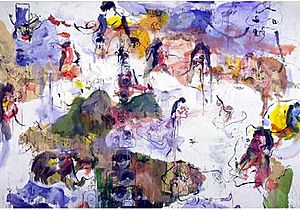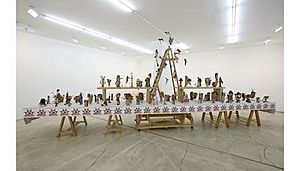Brad Kahlhamer facts for kids
Brad Kahlhamer (born in 1956) is an artist who creates many different kinds of art. He makes sculptures, paintings, and even performs music. He lives and works in New York City, in a place called Brooklyn.
His artwork is displayed in many famous museums. These include the Museum of Modern Art, the Whitney Museum of American Art, and the Metropolitan Museum of Art. His art is also in the Denver Art Museum, the Milwaukee Art Museum, and the San Francisco Museum of Modern Art.
Contents
Brad Kahlhamer's Art Journey
Brad Kahlhamer was born in Tucson, Arizona, in the United States. He was adopted by German-American parents and grew up in Wisconsin. He doesn't know his birth family because his adoption records were sealed.
Before becoming a full-time artist, Brad had an interesting path. For ten years, he was a musician who traveled around the Midwest. In 1982, he earned a degree in fine arts from the University of Wisconsin. After that, he moved to New York City. The lively city, especially areas like the Lower East Side, inspired his art. He also worked for ten years as a graphic artist and art director for Topps Chewing Gum Company. In 1993, he became a full-time artist.
Brad's art is influenced by his life experiences and exploring different cultures. He often talks about the "third place." This is where two different personal histories or ideas meet. He says, "Real events and people make up my characters. My work combines history, myths, and fantasy."
His art style is inspired by Abstract Expressionism. He also looks at graphic styles from artists like Gary Panter and Art Spiegelman. He studies Plains Indians' ledger drawings, which are historical drawings made by Native Americans. Brad also wrote about the painter Fritz Scholder for the Denver Art Museum. His work often mixes ideas from Native American culture with modern city life. He creates many pieces in a series, which become his most well-known works.
Brad's art also makes people think about what is "real" or "original" in Native American art. He explores these ideas in a way that makes his art unique and thought-provoking.
Paintings and Drawings
In 2000, an art show called Brad Kahlhamer: Almost American was held. An art expert named Laura Hoptman wrote that Brad's drawings are inspired by "ledger drawings." These are special drawings made by Native American people. They show how different cultures communicated long ago. Brad's art blends his interest in Native American history with modern times. This creates his "middle place" or "third place" in his art.
Loser + Clark
One of Brad Kahlhamer's paintings is Loser + Clark (1999). An art critic described how paint is applied in brushstrokes on a white background. This shows Brad's admiration for Abstract Expressionism. The painting has many different shapes. You can see animals, people in canoes, happy faces, and tall stacks of music amplifiers. There are also scribbled words and portraits. All these elements float through abstract landscapes with green hills and blue skies. The painting feels like the old Plains Indian ledger drawings, but with a modern, energetic feeling.
Eagle Fest USA
Eagle Fest USA (2005) is another great example of Brad's "third place" idea. This painting shows large, bold drawings that look like pop culture symbols. They also suggest the cycles of life and death. Brad uses dripping paint and thick lines to create his images. He mixes ideas from American Indian history and culture into a large, expressive painting.
Billy Jack Jr.
Brad Kahlhamer's Billy Jack Jr. (2006) includes many different symbols from popular culture. It shows expressive figures, animals, and symbols from specific Native American tribes. The artwork refers to the 1971 movie Billy Jack. This film showed how Native Americans faced unfair treatment during the civil rights movement. The story of Billy Jack, a hero who is part Native American and part white, adds to the story told in the painting.
Sculptures
Brad Kahlhamer calls his sculptures "Spiritual Advisors." He says they "sit like guards next to his paintings and drawings."
Bowery Nation
Bowery Nation (1985–2012) is a large art installation. It has over 100 small sculptures placed on a table. Brad was inspired to create this after seeing a huge collection of Hopi Kachina figures at the Heard Museum. An art writer said that Brad sees Bowery Nation as an "alternative tribe." Many of the pieces were made from objects found in New York's Lower East Side. This area has a long history of people from different countries moving there. Each figure is made from found objects in a spontaneous way. They show a mix of materials and ideas.
Super Catcher
Brad Kahlhamer also started making sculptures with wire, bells, and dreamcatcher shapes. He uses the dream catcher, which is a well-known symbol of American Indian culture. His piece Super Catcher (2014) hangs from the ceiling. It looks like a complex, spreading net made of wire and bells. Brad describes it as "aftermarket spiritual rebar." It has been described as "dream catchers caught in an old fisherman’s net, with small bells." This artwork was shown at the San Francisco Museum of Modern Art.
Music
Brad Kahlhamer is also a talented musician. He writes, performs, and produces music. He combines his experience in music and art. He also creates videos that use both his visual art and his music. In 2015, he said that the sounds he plays are "skeletal, jangly, wirey," much like the forms in his visual art. This shows how his work with different materials connects across painting, sound, and writing.
The artist has also created album artwork for the music group Man Man.
Past Exhibitions
- The Plains Indians: Artists of Earth and Sky, The Metropolitan Museum of Art, NY
- Bowery Nation, Nelson-Atikins Museum of Art, Kansas City, MO
- One Must Know The Animals, Madison Museum of Contemporary Art, Madison, WI
- Tale Spinning, Bates College Museum of Art, Lewiston, ME
- Rapid City, Denver Museum of Contemporary Art, Denver, CO
- The Old, Weird America: Folk Themes in Contemporary Art, Contemporary Arts Museum, Houston, TX
- American Soil, Nerman Museum of Contemporary Art, Overland Park, KS
- Radar, Denver Art Museum, Denver, CO
- Picturing Change; the impact of Ledger Drawing on Native American Art, The Hood Museum of Art, Dartmouth College, NH
- Supernova, San Francisco Museum of Modern Art, San Francisco, CA
- Five Years of the Altoids Curiously Strong Collection 1998-2002, New Museum of Contemporary Art, New York, NY
Awards
- Joan Mitchell Award
- Smithsonian Commission




